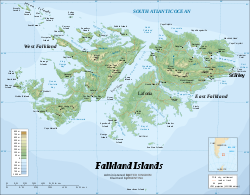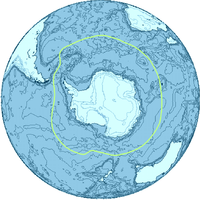
Climate of the Falkland Islands
Encyclopedia

Falkland Islands
The Falkland Islands are an archipelago in the South Atlantic Ocean, located about from the coast of mainland South America. The archipelago consists of East Falkland, West Falkland and 776 lesser islands. The capital, Stanley, is on East Falkland...
are located over 300 mi (483 km) from South America
South America
South America is a continent situated in the Western Hemisphere, mostly in the Southern Hemisphere, with a relatively small portion in the Northern Hemisphere. The continent is also considered a subcontinent of the Americas. It is bordered on the west by the Pacific Ocean and on the north and east...
, to the north of the Antarctic convergence
Antarctic Convergence
The Antarctic Convergence is a curve continuously encircling Antarctica where cold, northward-flowing Antarctic waters meet the relatively warmer waters of the subantarctic. Antarctic waters predominantly sink beneath subantarctic waters, while associated zones of mixing and upwelling create a zone...
, where cooler waters from the south mix with warmer waters from the north.
Winds mostly come from the west, creating a difference between the relative levels of precipitation between the eastern islands and the western islands. The total annual rainfall is only about 573.6 mm (23 in). Although snow falls, it does not settle due to the strength of the winds.
The temperature of the islands fluctuates within a narrow band, not reaching higher than 24 °C (75 °F) or lower than -5 C. There are long hours of daylight in the summer, although the actual number of hours of sunlight is limited by cloud cover.
Sunshine
During summer the Falklands experience long daylight hours. During summer the islands run on Daylight Saving TimeDaylight saving time
Daylight saving time —also summer time in several countries including in British English and European official terminology —is the practice of temporarily advancing clocks during the summertime so that afternoons have more daylight and mornings have less...
, at UTC -3 as opposed to the normal time of UTC -4, entering summer time at on the first Sunday of September and leaving it on on the third Sunday of April. However, due to cloud cover, the average number of hours in summer with direct sunlight is only 6 hours. The average number in winter is only 2–3. In 2011, the Falkland Islands government announced that the islands will remain on summer time during the winter, when the clocks would normally be set back.
Winds
The winds moving over the islands are mostly westerly winds. There is almost no seasonal variation in wind direction, which is less than 17 knots for 60 percent of the time, from 22 to 33 knots for 20–25 percent of the time, and 34 and above 8–12 percent of the time. Gales are frequent, especially during winter. Average wind speed in Stanley is 16 knots.Temperature

The archipelago is located 300 mi (483 km) from the coast of South America
South America
South America is a continent situated in the Western Hemisphere, mostly in the Southern Hemisphere, with a relatively small portion in the Northern Hemisphere. The continent is also considered a subcontinent of the Americas. It is bordered on the west by the Pacific Ocean and on the north and east...
, between 51° and 52°S. The location of the archipelago, to the north of the Antarctic convergence
Antarctic Convergence
The Antarctic Convergence is a curve continuously encircling Antarctica where cold, northward-flowing Antarctic waters meet the relatively warmer waters of the subantarctic. Antarctic waters predominantly sink beneath subantarctic waters, while associated zones of mixing and upwelling create a zone...
, helps to moderate the temperature as cool waters from Antarctica mix with warmer waters from the Atlantic.
Precipitation
Rainfall remains almost constant throughout the year, although it is low because of the archipelago's location to the east of South America. Due to the westerlies, the western side of the archipelago is much drier than the eastern side, and mountain ranges are much wetter on their eastern slopes than their western slopes. Port Stanley and Port HowardPort Howard
Port Howard is the largest settlement on West Falkland . it is in the east of the island, on an inlet of Falkland Sound...
on eastern islands both receive about 63 cm (25 in) of rainfall every year, as opposed to islands such as Westpoint which only receives 43 cm (17 in) a year. The overall rainfall for the archipelago is around 573.6 mm (23 in). During winter sleet
Sleet
Sleet refers to two distinct forms of precipitation:*Rain and snow mixed, snow that partially melts as it falls. *Ice pellets, one of three forms of precipitation in a US-style "wintry mix", the other two being snow and freezing rain. The latter is referred to as sleet mainly by the United States...
and snow
Snow
Snow is a form of precipitation within the Earth's atmosphere in the form of crystalline water ice, consisting of a multitude of snowflakes that fall from clouds. Since snow is composed of small ice particles, it is a granular material. It has an open and therefore soft structure, unless packed by...
does fall, but it is temporary and does not settle. Although the climate is semi-arid, the ground remains damp as it is often impermeable to water.
Effects of climate change
The climate has become drier and warmer over the past 50 years, but it is predicted that the islands will become cooler with more rain and cloud cover. This is because melting Antarctic ice is predicted to result in cooler air from the south, counteracting warmer air from the north. Sea temperature has also risen steadily since the 1960s. Rainfall data suggests that it increased from 1910 to 1940, decreased until 1995, then began to increase again. Storms are predicted to increase in frequency and intensity.This information has been determined through meteorological data from 1923 to 1981, with most recent data not being fully analysed. The temperature of the sea around the archipelago fluctuates greatly around predicted values.

